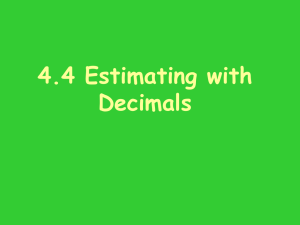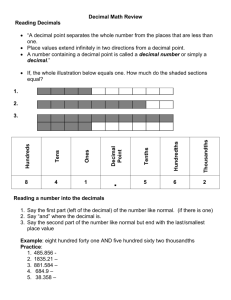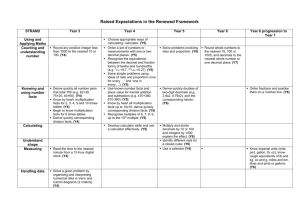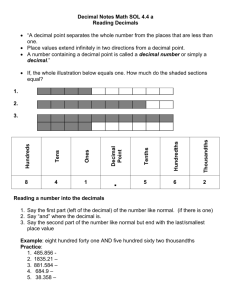Decimal Fractions – Teaching Guide - Wikispaces
advertisement
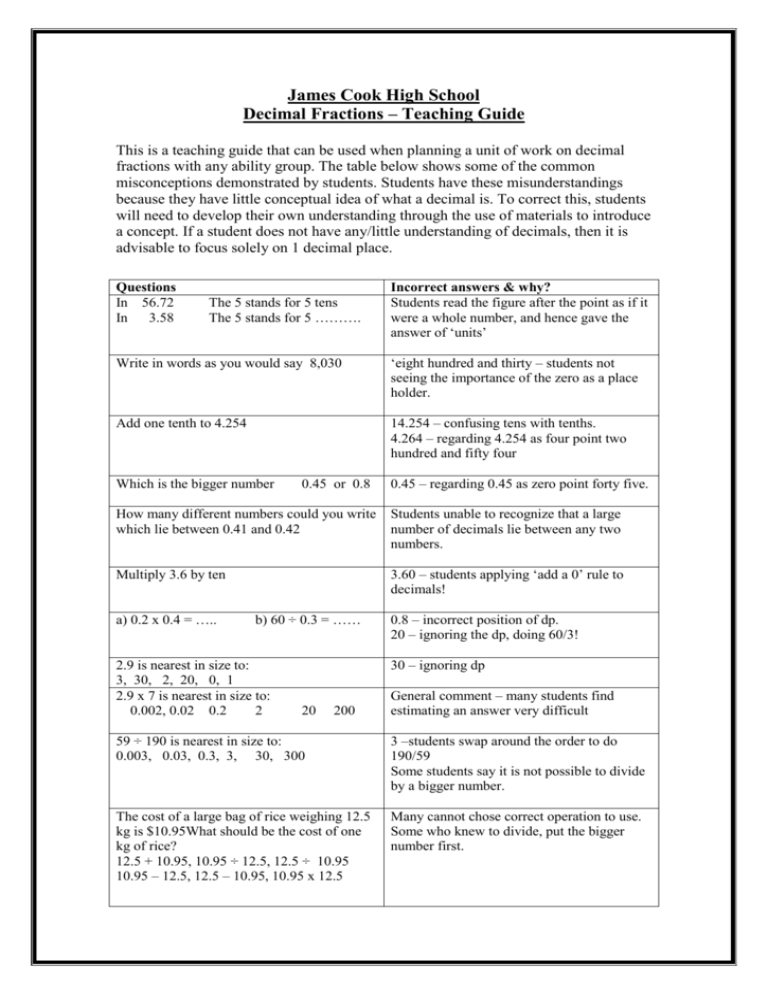
James Cook High School Decimal Fractions – Teaching Guide This is a teaching guide that can be used when planning a unit of work on decimal fractions with any ability group. The table below shows some of the common misconceptions demonstrated by students. Students have these misunderstandings because they have little conceptual idea of what a decimal is. To correct this, students will need to develop their own understanding through the use of materials to introduce a concept. If a student does not have any/little understanding of decimals, then it is advisable to focus solely on 1 decimal place. Questions In 56.72 In 3.58 The 5 stands for 5 tens The 5 stands for 5 ………. Incorrect answers & why? Students read the figure after the point as if it were a whole number, and hence gave the answer of ‘units’ Write in words as you would say 8,030 ‘eight hundred and thirty – students not seeing the importance of the zero as a place holder. Add one tenth to 4.254 14.254 – confusing tens with tenths. 4.264 – regarding 4.254 as four point two hundred and fifty four Which is the bigger number 0.45 or 0.8 0.45 – regarding 0.45 as zero point forty five. How many different numbers could you write which lie between 0.41 and 0.42 Students unable to recognize that a large number of decimals lie between any two numbers. Multiply 3.6 by ten 3.60 – students applying ‘add a 0’ rule to decimals! a) 0.2 x 0.4 = ….. b) 60 ÷ 0.3 = …… 2.9 is nearest in size to: 3, 30, 2, 20, 0, 1 2.9 x 7 is nearest in size to: 0.002, 0.02 0.2 2 0.8 – incorrect position of dp. 20 – ignoring the dp, doing 60/3! 30 – ignoring dp 20 200 General comment – many students find estimating an answer very difficult 59 ÷ 190 is nearest in size to: 0.003, 0.03, 0.3, 3, 30, 300 3 –students swap around the order to do 190/59 Some students say it is not possible to divide by a bigger number. The cost of a large bag of rice weighing 12.5 kg is $10.95What should be the cost of one kg of rice? 12.5 + 10.95, 10.95 ÷ 12.5, 12.5 ÷ 10.95 10.95 – 12.5, 12.5 – 10.95, 10.95 x 12.5 Many cannot chose correct operation to use. Some who knew to divide, put the bigger number first. Teaching Decimals – A Possible Sequence of Lessons Lesson Content 1. Introduction to Decimals Fractions(1dp) Resources See powerpoints on decimals folder on T drive. Focus on 1 decimal place. Start by introducing to students the need to have decimals. Ask what is one half as a decimal? Many will be able to say 0.5, but how many can explain what the five stands for! Use multicubes to introduce tenths. Example: Aroha has 6 packets of lollies to share amongst 5 people. How much will they each get? Each person gets 1 whole packet , leaving 1 packet remaining. Now introduce important concept – whenever we have 1 left over, we split it up into 10 equal parts. Splitting 1 whole up into ten parts creates tenths. How many tenths will each person get? So 6 ÷ 5 = 1 whole and 2 tenths. Note deliberate use of words. Also talk about the answer on a calculator – 1.2. Look at other examples, and model on multicubes and/or diagrams 7 ÷ 2, 8 ÷ 5, 6 ÷ 4, 11 ÷ 2 Decimal Place Value This activity will help to reinforce students the place of decimals in the number system. Students copy out a place value table(see opposite) and have to breakdown a number dec/frac/% booklet p22, 24 10 5 10 A good question to use for a ‘do now’ is to draw a scale with one value on and get the students to put as many answers as they can think of – encourage them to think of decimal and/or fractions. For example on this question; 0 and 100, 40 and 60, 49.5 and 50.5, 49.9 and 50.1 etc decimals booklet p 1-4 100 . E.g 567.4 → 500 + 60 + 7 + 4 This concept can be extended to hundredths, thousandths etc. The worksheets in the booklets provide extra activities to reinforce the position of tenths. There are some exercises on reading scales. When reading scales, students will make the mistake of only looking at the left number and assume each interval represents 1 unit. See example opposite – here students answer incorrectly 4.1! multicubes 6 7 4 5 4 ? ? 1 10 1 50 ? See powerpoints on decimals folder on T drive. 2. Adding and Subtracting Decimals(1dp) There are a variety of materials that can be used to model tenths; multicubes, decimats, pipe numbers. This explanation uses multicubes, but could easily be adapted for use with decimats or pipe numbers. Model on materials or diagram(the powerpoint has good examples) 1.2 + 0.4 – need to make a ‘sleeve’ around 10 multicubes to represent 1. Pose other similar problems: 1.3 + 0.6, 1.3 + 1.4, .0.9 + 2.2, 2.3 + 3.8 Multicubes Pipe numbers decimats Booklet p24, 27-33 Show on materials subtraction of decimals, e.g 1.2 – 0.7 Pose similar problems: 1.7 – 0.3, 1.3 – 0.6, 2.1 – 0.7, 3.4 – 1.6 …. There are a number of resources(see opposite column) that can be used to practice add/subtracting decimals. Do not let students use the algorithm. For weaker students, concentrate on just 1dp. 3. Addition/Subtraction Strategies with Decimals(1dp) During the addition/subtraction topic(book 5) students will have looked at different strategies to solve addition/subtraction problems. The set of resources in the additional decimals booklet use these methods applied to decimals. Students would benefit first from looking at reading decimal scales(see booklet p31). The example shown opposite is one using the ‘jumping the number line’ strategy. Strategies covered in ‘additional decimals booklet’: Compatible decimal fractions Decimal fractions – tenths Don’t subtract – add! Problems like 2.3 + ? = 7.1 Problems like ? + 2.9 = 8.1 Problems like 7.3 – 1.9 = ? 1.7 + 0.3 See powerpoints on decimals folder on T drive. = 8.1 6.0 0.1 Decimals booklet p 5-19 1.7 2.0 8.0 8.1 Jumping the number line Problems like 3.7 + ? = 8.9 Near doubles See powerpoints on decimals folder on T drive. 4. Rounding Decimals(1dp) The common rounding rule that “if the digit is over 5, go up” is in fact not always correct. Successive rounding of each decimal place in turn can lead to errors. For example, to round 4.48 to the nearest whole number, a common incorrect application of the rule is this: Round 4.48 to 4.5, round 4.5 to 5. Yet 4.48 is 4 to the nearest whole number. This issue does not exist when rounding 1dp to the nearest whole number, but it is worth students learning this method now, so that they can apply it to future work beyond 1dp. A reliable method for rounding is this: select the possible rounded number below and the possible rounded number above. See which of these the number to be rounded is closer to. For example, Round 8.6 to the nearest whole number. 8 8.6 9 Estimating Move onto using rounding for estimating answers. Students find this a difficult skill to master and they will need to have completed some work on general estimating with whole numbers, before moving onto decimals. To make it easier to begin with, give students questions which are multi choice. e.g 3.8 x 5 is closet to 2 15 20 200 Decimals booklet p 21 See powerpoints on decimals folder on T drive. 5. Multiplying/Dividing Decimals(1dp) by 10, 100, 1000 Students who have learnt the rule ‘add a zero to x by 10’ will incorrectly apply this to decimals e.g 3.4 x 10 = 3.40!! Consider 3.4 x 10. write 3.4 as 3 wholes and 4 tenths – model using decimats. Now: 10 x 3 wholes = 30 wholes, which gives us 3 tens (30) 10 x 4 tenths = 40 tenths, which gives us 4 wholes, hence 3.4 x 10 = 34.0 Go through similar problems modeling them on the decimats. Students can record the results in a place value table – see below. 100 10 3 7 2 4 2 6 4 0 1 3 43 7 2 0 5 6 9 0 3 Decimats x 10 Decimals booklet p 20 1 10 4 4 2 5 9 3 10 10 10 4 Students can look at these results and try and generalize a method for multiplying by 10 – encourage them to think of the numbers moving, not the decimal point. This concept can then be applied to multiplying by 100 and 1000. A similar approach can be used for dividing by 10. Using decimats, students can look at how tens, units etc, have to be broken up into ten parts for the division. 6. Games/Activities This is a selection of games/activities that can be used at any stage to help develop students understanding of decimals. They could be used as a ‘do now’ activity, or as a activity within the lesson. They can easily be adapted for work beyond 1dp. Forward and Backward Number Sequences Similar to that for whole numbers. Ask students to write down, for example, a number one tenth less than 4.0. What number is one tenth more than 15.9 etc. PIN Played in pairs. Students copy out a table with 4 columns – see opposite. One student 1 creates a 4 number PIN (e.g 347.2). The other student has to guess a number in their PIN. 100 10 1 10 The other student tries to guess their PIN. For example, they write 368.4. If the number is in the right spot use a P. If the number is in the students PIN but in the wrong place write a I, if the number is not in their PIN write a N. So for the guess 368.4, we would write PNNI. Students can then swap roles. 5 6 7 4 Number Hangman Use the same table as used for the PIN activity. Students play in pairs. One asks the other questions about specific places, like, “is there a five in the tens place?”. They may also ask digit related questions, like, “does the number have the digit eight anywhere?”. Is the tenth digit odd?”, Is the hundreds digit greater than five?”. Each time there is a “no” to a question, a piece is added to the hangman. ZAP Students work in pairs. One student begins by putting a number into the calculator, for example, 3.5. Then an instruction is given. “Zap out the 5 in the 3.5”. Here 3.5 – 0.5 “zaps” the 5. Encourage students to use other buttons on the calculator, not just the add or subtract. Four in a line See 10 ticks worksheets, level 5 pack 2 page 25 Decimal Archery See 10 ticks worksheet, level 5 pack 2 page 20. Possible Sequence of Lessons for Hundredths(and beyond!) See powerpoints on decimals folder on T drive. 1. Introduction to Decimal fractions (2dp) This follows a similar concept as shown for 1dp, however, multicubes cannot be used as they cannot be broken down to show hundredths. Use decimats, or ‘pipe numbers’.. Example: Aroha has 5 bars of chocolate to share amongst 4 people. How much will they each get? Each person gets 1 whole packet , leaving 1 packet remaining. Now follow the golden rule, whenever there is one left over, split it up into ten parts. Splitting 1 whole up into ten parts creates tenths. How many tenths will each person get? Each person has 1 whole and 2 tenths. This leaves 2 tenths, each of which is split into ten parts. Ask students what do we call this smaller part(hundredths). Left with 20 hundredths to share amongst 4 people So 5 ÷ 4 = 1 whole and 2 tenths and 5 hundredths. Note deliberate use of words. Also talk about the answer on a calculator – 1.25. Look at other examples, and model on multicubes and/or diagrams 7 ÷ 4, 9 ÷ 4, Decimals booklet p 38 Decimals booklet p 23-27 Decimal Place Value This activity will help to reinforce students the place of decimals in the number system. Students copy out a place value table(see opposite) and have to breakdown a number . E.g 507.48 → 500 + 7 + 4 + 10 8 100 This concept can be extended to thousandths, ten thousandths etc. The worksheets in the booklets provide extra activities to reinforce the position of hundredths. There are some exercises on reading scales. When reading scales, students will make the mistake of only looking at the left number and assume each interval represents 1 unit. See example opposite – here students answer incorrectly 4.1! 100 5 10 1 0 7 1 100 4 8 5 4 A good question to use for a ‘do now’ is to draw a scale with one value on and get the students to put as many answers as they can think of – encourage them to think of decimal and/or fractions. For example on this question; 0 and 100, 40 and 60, 49.5 and 50.5, 49.9 and 50.1 etc 1 10 ? 50 ? ? 2. Adding/Subtracting Decimals Decimats or pipe numbers could be used as materials to model hundredths etc. When students are doing adding/subtraction of decimals, it is important that you do not allow them to use the algorithm, until they have developed a good understanding and are confident of working with decimals mentally. See add/subtracting decimals for 1dp for teaching ideas. There are a number of resources(see opposite) that can be used to give students practice of adding/subtracting with hundredths. 3. Ordering Decimals A common misconception for students to have is to say, for example, 0.25 is bigger than 0.5 “because 25 is bigger than 5”. Hopefully, after being taught the previous lessons, they will have a better understanding of decimals, in particular the importance of place value. Questions will need to be modelled on materials first to help imbed the concept of place value, and hence lead them to order decimals correctly. Note there is a good powerpoint(ordering decimals) that illustrates this concept well. Example: which is bigger 0.32 or 0.5 – ask students to draw a picture to prove their answer. How can you say quickly that 0.45 is bigger than 0.3999909746! Should be looking for students to comment on the fact that one number has 4 tenths, the other 3 tenths, so the other numbers are not significant. See powerpoints on decimals folder on T drive. Decimals booklet p 28-30 See powerpoints on decimals folder on T drive. Decimals booklet p 22, 31 0.32 0.5 4. Reading Decimal Number Lines When drawing a number line to show, say, 3.45 with 3.4 and 3.5 as the end points, students easily lose track of the position of 0 on the line. Being able to solve such a problem is a powerful indicator that the students’ knowledge of the decimal place value system is good. This activity is not easy and needs careful teaching. . Problem: “If 3.4 and 3.5 are marked 10 divisions apart on a number line, where is the number 0?” Get the students in groups to mark 3.4 and 3.5 on a number line with 10 1-centimetre gaps between the 2 numbers. Discuss why the 3.4 3.5 distance from 0 to 3.4 is 34 x 10 centimetres. Get the students to use a metre rule to locate 0. Problem: “Outside place 2 pegs, representing 4.5 and 4.6 on a number line, 1 pace apart. Your task is to locate where 0 would be on the number line.” Put the students into groups of 3 or 4 and discuss what they are going to do outside on the field. Show them the task on the board. They will put a marker on the ground to represent 4.5. One student in each group takes a pace to represent 4.6, and this point is marked with 4.6. The students’ task now is to mark where 0 is. (The group moves 45 paces back from 4.5 using the pace of the selected student.) Examples: The space between the given numbers represents one pace. Find 0 in each case: 2.2 to 2.3, locate 0. (Answer: 0.1 is 1 pace, so they need 22 paces back from 2.2.) 0.45 to 0.46, locate 0. (Answer: 0.01 is 1 pace, so they need 45 paces back from 0.45.) dec/frac/% booklet p28 See powerpoints on decimals folder on T drive. Dec/frac/% booklet p32, 34 0.023 to 0.024, locate 0. (Answer: 0.001 is 1 pace, so they need 23 paces.) 150 to 160, locate 0. (Answer: 10 is 1 pace, so 150 is 15 paces.) 3 300 to 3 400, locate 0. (Answer: 100 is 1 pace, so 3 300 is 33 paces.) Examples: 2.02 to 2.03 are 10 centimetres apart on a number line. How far is it to 0? (Answer: 0.01 unit = 10 centimetres so 1 unit is 100 x 10 centimetres = 10 metres. So 2.02 is 2.02 x 10 = 20.2 metres back to 0.) 67.5 to 67.6 are 1 metre apart on a number line. How far is it to 0? 907.05 to 907.06 are 10 centimetres apart on a number line. How far is it to 0? 5. Rounding Decimals Whole number rounding is a gentle yet important introduction to using number lines to round decimal numbers sensibly.. Problem: “Betty’s Appliance Store prices TVs to the nearest $10. If the exact price is $567.78, what does Betty charge?” Discuss why the choices are 560 and 570 and enter these at the end of the number line 10 units apart. Discuss why 567 is 7 divisions along from 560. Discuss why 567.78 is nearer 568 than 567 and locate 567.78 with an arrow on the number line. Discuss why 567.78 = 570 to the nearest 10. 560 567.78 570 Examples: Stories for rounding on number lines: $456.89 to the nearest $10 $2,345.09 to the nearest $10 $7,456 to the nearest $100 $24,509 to the nearest $1,000 Problem: “A builder works out the price of building a house as $123,566.89. He quotes a price to the nearest $1,000. What is his price?” Discuss the two alternatives ($123,000 and $124,000). Ask the students to draw an empty number line (Material Master 8–11) and put 123 000 and 124 000 at the ends. Ask where 123 500 would be on the number line. (Answer: Half way.) So is 123 566.89 closer to 123 000 or 124 000? (Answer: 124 000. So the builder charges $124,000.) Examples: Stories for rounding on empty number lines: $345,902.89 to the nearest $1,000 $266,345.09 to the nearest $100 $794,856.23 to the nearest $10,000 $5,624,509 to the nearest $100,000 Examples: Stories for rounding without number lines: 9 099.99 to the nearest 10 795.078 to the nearest 100 94 756.2309 to the nearest 10 000 999.999 to the nearest 1 11.89 to the nearest 1 10 890.8 to the nearest 100 956.2709 to the nearest 10 999 999.9 to the nearest 1 See powerpoints on decimals folder on T drive. Decimals booklet p39 A number rounds to 345 800 to the nearest hundred. What kind of number could it be? Problems with “if it’s 5 round up!” The common rounding rule that “if the digit is over 5, go up” is in fact not always correct. Successive rounding of each decimal place in turn can lead to errors. For example, to round 4.48 to the nearest whole number, a common incorrect application of the rule is this: Round 4.48 to 4.5, round 4.5 to 5. Yet 4.48 is 4 to the nearest whole number. A reliable method for rounding is this: select the possible rounded number below and the possible rounded number above. See which of these the number to be rounded is closer to. Dec/frac/% booklet p34, 36 Problem: “Place 2.3429678335 on a number line between 2.34 and 2.35 as accurately as possible.” Write 2.3429678335 on the board and draw a number line with 10 divisions on the board as wide as the board. (The divisions need only be roughly equal, as measuring them will take too long. (All the better if the board is the width of the room!) Discuss where 2.342 is. Draw 10 divisions between 2.342 and 2.343. Locate 2.3429. Continue locating 2.3429678335 decimal place by decimal place until the interval is too small to continue. 2.34 2.342 2.343 2.35 Examples: Round the following to a number of decimal places: 3.567 to 2 dps 12.5697 to 1 dp 109.780678 to 4 dps 0.002376 to 5 dps 10.09 to 1 dp 12.5067 to 3 dps 56.597 to 1 dp 0.0000371 to 5 dps 1.59709272 to 6 dps 6. Multiplying/Dividing Decimals by 10, 100, 1000 See multiplying/dividing decimals by 10, 100, 1000 (1dp) in the previous section. Similar methods can be used to illustrate the x/÷ by 10, 100 and 100 for decimals with hundredths(and beyond) See powerpoints on decimals folder on T drive. decimats Decimals booklet p32 - 36 7. When Big Gets Smaller - When Small Gets Bigger! Problem: “Nara buys 0.345 kilograms of chocolates, which costs $9.78 per kilogram. Work out the approximate cost. Is the answer less than or more than $9.78?” (Possible answer: 0.345 x 9.78 = 3 tenths of 10 = 3. So the answer is less than $9.78.) Use the calculator to find the cost of the chocolates and round sensibly.) (Answer: 0.345 x 9.78 = 3.3741 = $3.37 to the nearest cent.) Examples: Worksheet (Material Master 8–15). When Small Gets Bigger Students’ experience with whole numbers leads them to expect that multiplying results in an answer that is “larger” and that dividing results in an answer that is “smaller”. However, 23.9 ÷ 0.0891 is larger than 23.9 not smaller. The whole number expectation holds for fractions greater than one but fails for fractions between one and zero. Problem: “Maurice works at the supermarket. He has to cut up 4 kilograms of cheese into 0.5-kilogram packs for sale. How many packs will he make?” “What is 4 ÷ 0.5?” Write 4 ÷ 0.5 on the board. Get the students to make a strip like this representing the 4 kilogramsof cheese: Then get them to cut the strip into “1-kilogram” pieces. Discuss how to create 0.5-kilogram packs. (Answer: Cut each piece in half.) Do the cutting. How many pieces are there? (Answer: 8.) Discuss why 4 ÷ 0.5 = 8. “Is it a surprise that the answer is more than 4?” Examples. Use paper and cutting for word stories: 3 ÷ 0.5 2 ÷ 0.25 3.5 ÷ 0.5 1 ÷ 0.25 2.5 ÷ 0.5 ... Problem: “Morrie has 5 kilograms of chocolate. He puts the chocolate into separate packets of 0.25 kilograms. How many packets will Morrie make?” “What is 5 ÷ 0.25?” Write 5 ÷ 0.25 on the board. Get the students to imagine what Morrie would do to 1 kilogram of chocolate. (Answer: He would make 4 packets.) “How many bags can he make?” (Answer: 5 x 4 = 20.) Write 5 ÷ 0.25 = 20 on the board. Examples: Imagine how to solve these problems. Word stories and problems for: 3.5 ÷ 0.5 1.25 ÷ 0.25 8 ÷ 0.5 2.5 ÷ 0.25 ... Using Number Properties Examples: Worksheet (Material Master 8–16). Understanding Number Properties: How will you decide whether the answers to problems like 345.67 ÷ 1.008 or 2345.09 ÷ 0.012 are bigger or smaller than the number being divided? Understanding Number Properties: z ÷ y is always smaller than z when y is ... z ÷ y is always bigger than z when y is ... See powerpoints on decimals folder on T drive. Decimals booklet p 40-41 See powerpoints on decimals folder on T drive. 8. Estimation with Decimals Problem: “Estimate 0.503 x 58.7.” Discuss why 1 x 60 = 30 is sensible. 2 Problem: “Martha gets 34.56 ÷ 0.98 = 33.8688 on her calculator. Is she correct?” (Answer: Martha must be wrong as division by a number less than 1 makes the answer bigger.) Problem: “Estimate 59.89 x 0.091.” (Possible answer: 59.89 x 0.091 ≈ 60 x 0.1, and 1 tenth of 60 = 6.) Examples: Worksheet (Material Master 8–17). Decimals booklet p 37 9. Multiplication of Decimal Fractions This method uses areas of rectangles to model the multiplication of decimals. Problem: “John wants to find the area of a rectangle 1.4 by 0.3. Because 1 tenth x 1 tenth = 1 hundredth, John decides to make one unit of area equal the square with 100 little squares.” Get the students to use Material Master 8–34 to draw the following: 2 units 1.4 units 0.3 of 1.4 units See powerpoints on decimals folder on T drive. Discuss how the pictures show 0.3 of 1.4 = 42 little squares. (Answer: 3 columns of 14 are shaded in the third picture which gives 3 x 14 = 42 little squares.) Discuss what fraction of a square unit is shaded. (Answer: = 0.42.) Discuss the quick way of seeing 0.3 x 1.4 = 0.42. (Answer: 3 tenths of 1.4 is less than 1, in fact about 0.5. The answer has 42 in it. So it must be 0.42.) Examples: Repeat for: 1.2 x 0.2, 1.2 x 1.2, 0.9 x 0.8, 1.2 x 1.1 Problem: “John notices a pattern in the answers above. He immediately reasons the answer to 2.5 x 1.3 must be 3.25. Explain.” (Answer: John calculates that, ignoring the decimal point, 25 x 13 = 325. And 2.5 x 1.3 is between 2 x 1 = 2 and 3 x 2 = 6, so the answer must lie between 2 and 6, which means that the point must follow the 3.) Problem: “John’s calculator is malfunctioning. It gives digits in the answer correctly but is not showing the decimal point. He puts 178 ÷ 0.0892 into the calculator and gets 1995515695 on the screen. Where should the decimal point go?” (Answer: 178 ÷ 0.0892 ≈ 200 ÷ 0.1 = 2 000. So the answer is 1995.515695.) Examples: Estimate the answer then put the decimal point in the correct place: 9.789 x 0.12 = 117468, 10.11 x 9.9 = 100089, 4.9 x 0.51 = 2499, 78.6 ÷ 0.88 = 893181818, 6.76 ÷ 0.026 = 26, 2.5 x 2.5 = 625 ... Understanding Number Properties: Describe how you would know where the decimal point will be in the answers to a) 234.567 ÷ 24.987 b) 0.0123 x 678.34


